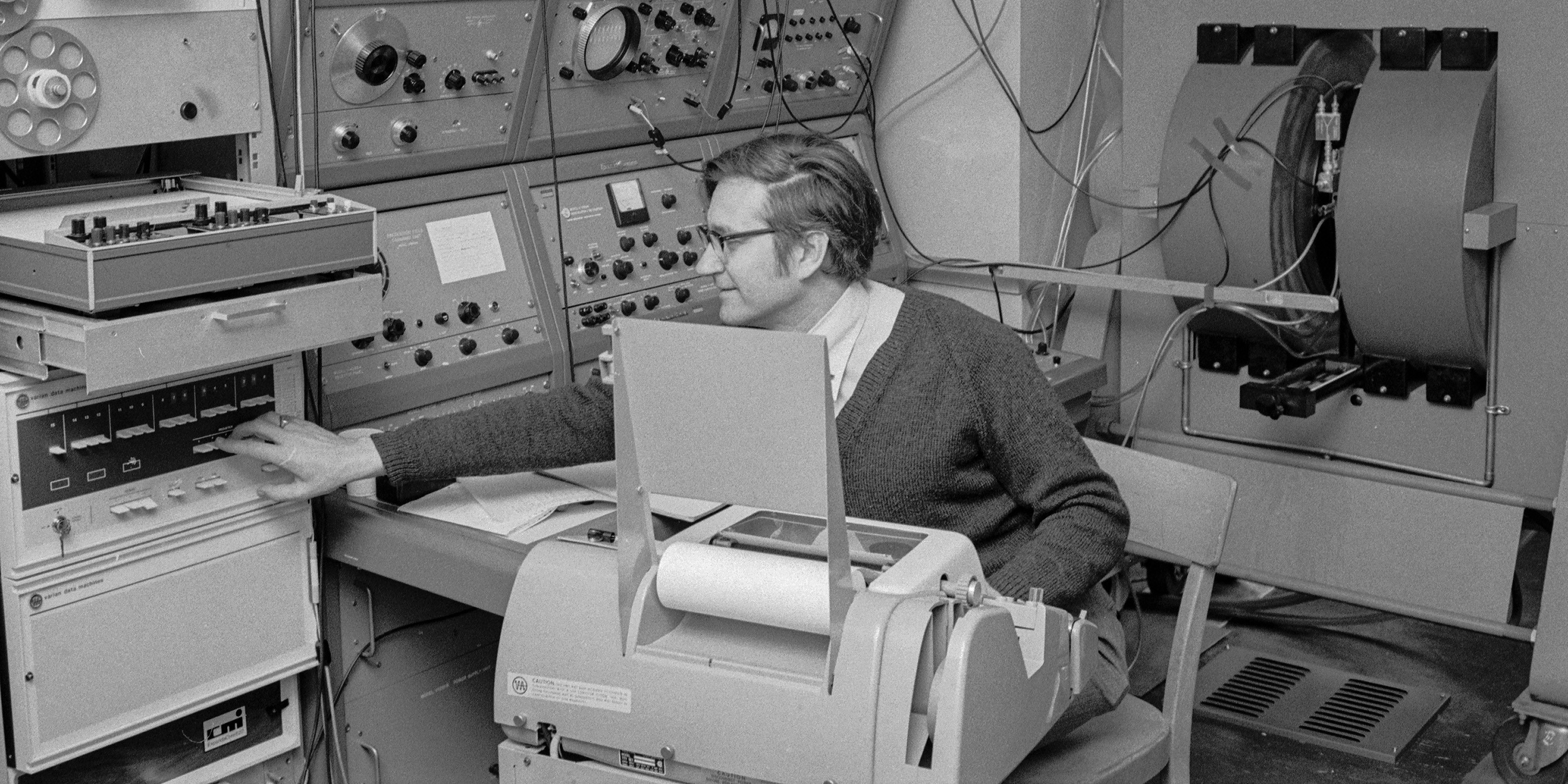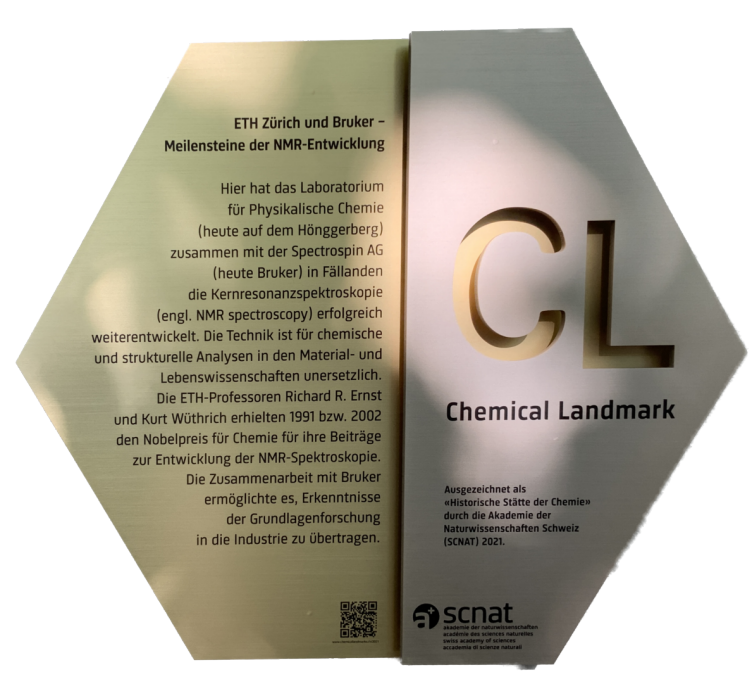
Chemical Landmark: The development of NMR
In science, it is better to work together than alone and sometimes such collaborations lead to a true revolution. This is what happened in the 1970s, when the Institute of Physical Chemistry at ETH Zurich, together with Bruker, ushered in a new era of nuclear magnetic resonance spectroscopy, significantly expanding the possibilities for chemical analyses in the materials and life sciences. Now, SCNAT honored both sites with the Chemical Landmark. A historical journey.
Please note: Click here to get to the podcast and to the exhibition details.

Anyone who is cycling past Universitätsstrasse 22 in Zurich or Bruker at Industriestrasse 26 in Fällanden in the next days, may notice a new sign on the walls. The Swiss Academy of Sciences (SCNAT) recently awarded both sites with the Chemical Landmark. It is a small plaque that marks a big chemical milestone, in this case in a scientific and literal sense. That becomes clear whenever people find themselves, for instance, in the buzzing interior of a big MRI machine at the hospital, or when people marvel at the eight-ton 1.2 GHz magnet in the hall of the D-CHAB on the Hönggerberg, that provides deeper insights into the molecular world than any magnet of this kind before.
The basis for both is nuclear magnetic resonance spectroscopy or NMR. Today, it is irreplaceable as an analytical method for chemistry, materials science, biology and medicine. Thanks to this method, chemical structures, properties and reactions of atoms, molecules, liquids and solids can be studied in a non-destructive manner.
In contrast to other methods, NMR is very gentle to the samples: They are exposed to a strong magnetic field. The atomic nuclei of the molecules in the sample are aligned by the magnetic field and are irradiated with radio frequency. The nuclei absorb the energy and release it at a specific frequency (resonance frequency). Nobel Prize laureate Professor Richard Ernst once compared this to playing the piano: if you strike the strings, they begin to vibrate at their own resonant frequency and produce tones that can be assigned. In the case of the NMR method, the energy emitted does not produce a simple tone, but an electrical signal, which is finally reflected in a so-called NMR spectrum. The waves displayed there map the resonance frequencies of the atomic nuclei and make it possible to determine the molecular structure. The sample itself is not affected or damaged.

How a cacophony led to good NMR results
When Richard Ernst did his doctoral thesis at ETH Zurich in 1955, clear NMR results were still a long way off. It is true that ETH was already in the process of developing new promising NMR spectrometers – together with the company Trüb, Täuber und Co AG and also on its own initiative. However, the knowledge about NMR and the necessary technology were still relatively young and half-baked. In hours of work, resonance frequencies were sampled one by one, so to say note by note, to stay with the piano picture. The results were still not satisfying: The magnetic fields were too weak and so were the signals that were sent back by the atomic nuclei. That’s why the signals were constantly superimposed by the noise of other electromagnetic signals. Ergo: no clear result.
During his postdoctoral studies at Varian in California – the leading NMR spectrometer manufacturer at the time – Richard Ernst finally tried a brute force approach and pressed all the piano keys at once: a "cacophony ", as he wryly noted in his biography. Translated into NMR language, this means: Instead of irradiating the sample with single radiofrequencies, he used a broadband pulse. In one fell swoop, all nuclei were excited, which shortened the experiment to milliseconds. Ernst finally mastered the resulting chaos of signals with the so-called Fourier transform – a mathematical operation that turns the diffuse forest of signals into a sharp, interpretable frequency spectrum. The constant progress in technology contributed as well and the method became established, also in Switzerland. In Zurich, however, at the beginning the streetcar next to the CHN building interfered with the magnetic field of the NMR devices, so that reliable measurements could only be obtained between 1.30 and 4 am, as Ernst – who had just returned to ETH – complained in a letter. Nevertheless, this could not stop the progress.

Fruitful collaboration
At that time, Varian had patented Ernst's invention, but had not really recognized its importance. In the end, it was the German-Swiss company Bruker in Fällanden who developed and built the new generation of NMR spectrometers: In addition to the Fourier method, Bruker also used superconducting magnets, which generated significantly higher and more stable magnetic fields.
In 1976, Ernst investigated multidimensional spectroscopy for biomolecules together with Kurt Wüthrich. Due to lack of space, the two worked door to door in office containers on the roof of the CHN building. Using a mixture of 2D NMR spectroscopy and Fourier transformation, they finally managed to measure not only the chemical composition of molecules but also the distance between individual atoms and their interactions. This paved the way to analyze the structure of complex molecules such as proteins. To this day, this method is the basis of all MRI methods, which many people know as an analytical tool in hospitals.
Richard Ernst (1991) and Kurt Wüthrich (2002) received the Nobel Prize for their contributions. Their publications and patents, but above all the fruitful collaboration with Bruker, formed the basis for the further development of the NMR method and ensured that the findings could be transferred to industry. The Chemical Landmark-plaques on the buildings at Universitätsstrasse 22 and Fällanden are also intended as a reminder of this special collaboration that led to so many new technical and chemical insights.
The last pearl of progress in the field of NMR is, by the way, already working in the halls of the ETH building HCI: Bruker's NMR magnet with 1.2 gigahertz and 28 Tesla. It is the strongest persistent magnet in the world so far, stored far away from the CHN building and disturbing streetcars, capable of providing deeper insights into the molecular world than any NMR magnet before and so heavy that in 2020 it took a crane and many helping hands and hours to transport it to the hall ... but this is another story.
Curious for more?
Listen to our special NMR-Podcast Episode

Prof. Beat Meier and Prof. Matthias Ernst - both from the LPC at D-CHAB - have largely witnessed the development of NMR, also as PhD students of Richard Ernst. Until today, both are doing research in this field at ETH and use the method. An exciting chat for everyone who wants to know more about how NMR works, how the method has been developed and what fascinating things can be done with it.
Please note: This podcast episode is only available in German.
Take a look at our small exhibition: NMR and Richard Ernst
Take a look at our small exhibition about NMR and Richard Ernst in the Infozentrum Chemie | Biologie | Pharmazie and discover an interesting selection of exponats, documents and books. The opening hours correspond to the hours of the information center, entrance is free.
Check out the map of the Chemical Landmarks by SCNAT
The program «Chemical Landmarks» was established to identify and manifest the scientific and technological heritage by awarding sites which have played a significant role in the history of chemistry in Switzerland. Switzerland in particular owes a major part of its wealth to chemistry with its discoveries and successes in research and the ensuing chemical industry. The goal of the program is to recognise the historical sites and to emphasize and foster public interest in the chemical sciences. Annually, one historic site is selected and awarded during an official ceremonial act.
Find the map of the Chemical Landmarks external page here.